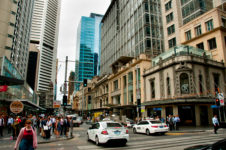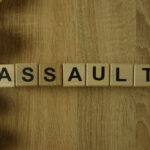“Shoot Me in The F***ing Head”: Knife Attack in Sydney CBD

It has been reported that at around 2pm this afternoon, a man walked along York Street in the Sydney CBD armed with a knife before stabbing a woman, after which he was subdued by members of the public.
Video footage shows the man climbing on top of a Mercedes Benz station wagon at the corner of King and Clarence streets, wielding the knife and shouting “shoot me in the fucking head”.
The man is then held down by members of the public, using a milk crate and a chair. One of the men says “You stabbed a chick, mate”’.
A witness later wrote on Twitter:
“So insane! A random dude just started stabbing people in the city right outside where we were having lunch. I saw people running so I ran towards him with a few other guys.
He ran all the way back to near my work where a lot of others had cornered him for the police!”
Police have since released the following statement:
“About 2pm, emergency services responded following reports a man was walking along York Street, Sydney, armed with a knife”.
“As police made their way to the location, there were multiple reports the man had stabbed someone near the corner of King and Clarence Streets”.
“Police and NSW Ambulance paramedics located a woman inside a hotel, who had a stab wound. She has been taken to hospital in a stable condition”.
The man was arrested and taken to Day Street Police Station where he is expected to be processed.
Charges are likely
Given the current reports, the man is likely to be transported to a hospital for an assessment of his mental state before facing the possibility of criminal charges.
Assault Occasioning Actual Bodily Harm (AOABH)
AOABH is an offence under section 59 of the Crimes Act 1900 (‘the Act’) which carries a maximum penalty of five years’ imprisonment, or seven years if committed in the company of at least one other person.
‘Actual bodily harm’ (ABH) is that which is more than ‘transient or trifling’; in other words, more than slight harm – such as minor redness or passing scratches – which quickly subside; Donovan [1934] 2 KB 498.
Examples of ABH may include bruises or lasting scratches or swelling; McIntyre v Regina (2009) 198 A Crim R 549 at para [44].
Transient emotions, feelings or states of mind do not amount to ABH unless there is evidence of very serious psychological harm, or psychiatric injury; Li v R [2005] NSWCCA 442 at [45]; Chan Fook (1994) 1 WLR 689.
Wounding
A ‘wounding’ is where both layers of skin are broken, namely the dermis and epidermis; Shepherd [2003] NSWCCA 351.
It encompasses all cuts which penetrate into the flesh, and even a ‘split lip’; R v Hooper [2004] NSWCCA 10 at [36]
Reckless wounding is an offence under section 35 of the Act which carries a maximum penalty of seven years’ imprisonment, or ten years if committed in the company of another person.
Section 33 of the Act prescribes a maximum penalty of 25 years’ imprisonment for wounding with intent to cause grievous bodily harm.
Grievous Bodily Harm (GBH)
GBH covers the most serious types of injury, and has been defined by the common law as ‘really serious harm’; DPP v Smith [1961] AC 290; Haoui v R (2008) 188 A Crim R 331.
Section 4(1) of the Act says GBH includes:
- The destruction of a foetus,
- Any permanent or serious disfiguring, and
- Any grievous bodily disease.
However, this is certainly not an exhaustive list, and juries are often left to decide whether a particular injury is ‘really serious’.
The Public Defenders Sentencing Tables provide some guidance about the types of injuries considered ABH and GBH. Injuries sentenced as ABH include:
- Bleeding from head,
- Serious bruising, and
- Abrasions to shoulder and arm.
However, there are also more serious examples which could arguably amount to ‘really serious harm’, including:
- Skull and brain damage,
- Stabbings with knife, and
- Bleeding requiring stitches and broken ankle.
Injuries sentenced as GBH include:
- Fractured right arm,
- ‘Glassing’ of face requiring stitches,
- Gaping wound to face and throat requiring large number of stitches, and
- Severe facial and cranial injuries.
Affray
Affray is an offence under section 93C of the Act which carries a maximum penalty of 10 years in prison.
The section provides that it is an offence where a person “uses or threatens unlawful violence towards another and whose conduct is such as would cause a person of reasonable firmness present at the scene to fear for his or her personal safety”.
The legislation makes clear that:
- an affray cannot occur by the use of words alone,
- a person does not need to be present at the scene for an affray to occur, and
- the offence may be committed in private as well as in public places.
Possible murder
Since the initial coverage, it has been reported that a woman was found deceased inside a city building later in the afternoon. According to police:
“Inquiries are underway after the body of a woman was found inside a unit on Clarence Street about 3.15pm”.
“Officers from Sydney City Police Area Command are on the scene and will conduct inquiries into whether the incident is linked to” the earlier alleged stabbing.
It remains to be seen how the alleged assailant will be dealt with.






